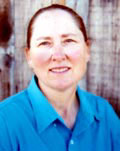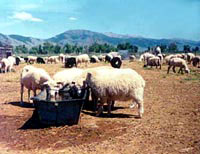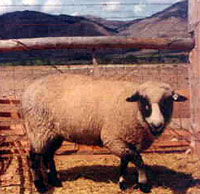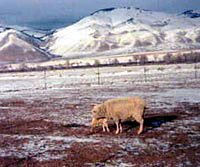
Louise Wagenknecht writes from Leadore, Idaho, where she juggles words, sheep, and a part-time job with the U.S. Forest Service. Her essays have appeared in High Country News, the American Nature Writing anthologies, and The River Reader.
Monday, 7 Feb 2000
LEADORE, Idaho
This morning, just as the sun came up over Powderhorn Ridge across the valley, a golden eagle landed in the dead top of the big cottonwood tree along the irrigation ditch just west of our house. The starlings hunched in the cold (five degrees above zero) only moved over a little for her, unafraid. The eagle is checking out the pile of sheep guts in the field behind the back fence (I butchered a couple of last year’s lambs yesterday for meat). I had hoped that putting the pile so far away might attract the bald eagle wintering nearby, living on winter-killed cow carcasses, but the ravens got there first, and are not about to relinquish it.
I look out the window at the sheep corrals, where ewes lounge around the hay racks, soaking up the pale February sun, not very warm at 6,000 feet. A couple of ravens stalk through the snow around them or play tag on top of the racks. This morning there is — blessedly — no wind.

Bob and a dog.
Our senior Great Pyrenees guard dog, Mitzi, emerges from her nest in a hay rack, stretching. She lives with the sheep, never approaching the house. She has been with them since puppyhood, and is bonded to them. Guard dogs are said to regard themselves as alpha sheep, but as one of the old leader ewes approaches her, she wags her tail and grins and rolls onto her back — submissive gestures. But without Mitzi to patrol the fencelines and guard them, we would lose lambs to predators — mostly coyotes, although the lone wolf that killed a neighbor’s lamb last year came here first, and was evidently intimidated by Mitzi defending her turf. We found his big tracks outside the fence the next day.
With Mitzi, we have never “needed” to shoot or trap predators. We have long believed what wildlife researchers confirm — that killing predators is counterproductive both ecologically and economically. A few years ago we became certified as a Predator Friendly (PF) livestock operation. Since then we have marketed most of our wool to a Montana outfit which trademarked PF Wool, and which sells sweaters, hats, and blankets made from it.
My husband, Bob, and I have been raising sheep here in this dry valley for 10 years. We own seven acres of rocks and sagebrush, leasing a hundred more from a neighbor. Our valley gets eight inches of rain or snow a year. What water there is melts off the mountains in spring and summer, and is funneled into the irrigation ditches of those who have water rights. We have none, so we have to buy all the hay we feed in winter. The big field provides two or three months of grazing for our flock of 60 whiteface ewes, but by July the grass has dried up. Like most small livestock producers in the West, we have no public lands grazing permits, so unless we can rent irrigated pasture, we have to start feeding alfalfa hay again to keep the lambs growing.
February is a quiet time here, cold and beautiful. The ewes will begin lambing March 1. We have a shed to shelter newborn lambs and their mothers, and sheltered “mixing pens” where lambs up to a few weeks old can live with their mothers, but not enough barn space to bring all 60 pregnant ewes inside at night. So all through March, one of us must walk outside every two hours, all night long, to check “the drop bunch.”
I hear Bob putting on his boots downstairs. Feeding time! See you all tomorrow.
Tuesday, 8 Feb 2000
LEADORE, Idaho
Yesterday afternoon we saw the owl again! All winter, a northern pygmy owl has been hanging out near the haystack, presumably looking for mice. Less of a night-lover than most owls, it’s about the size of a robin, but with a big earless round head. It is remarkably tame. Last week, it flew down between us on the path to the haystack, and Bob crept forward and actually touched its striped breast feathers. When we didn’t see it for several days, we were afraid it might have been sick or starving. But yesterday, there it was again, fluffed up and sitting complacently on a post, glaring at us.
About eight o’clock this morning, Bob spotted four or five deer moving slowly across the back pasture and then gliding between the fence wires and out onto the Bureau of Land Management land to the west. It’s unusual to see them in this open country in the daytime. They are mule deer, part of a bunch whose home range includes the small creeks and irrigation ditches around Leadore, where they can hide in willows and cottonwoods, venturing out onto the open sagebrush flats at night. Whitetail deer, of which there are more and more these days, stay closer to the river and its hay meadows.

The hungry sheep look down; they are fed.
Yesterday we started feeding the sheep in the morning. Researchers at Minnesota’s Pipestone Institute have found that feeding ewes in the morning, beginning three weeks before lambing, will encourage most ewes to give birth in the daytime, although about 15 percent still insist on having their lambs in the dark. The system works — mostly.
With the ewes bellied up to the hay racks, I look at their udders and bellies. A few of the older ewes are beginning to waddle, their abdomens swaying broadly on either side of their hind legs, their udders swelling and filling with the colostrum that will nourish their lambs for the first two days of their lives. Colostrum is thicker and yellower than normal milk, and contains antibodies to protect the lambs against the germ-laden world.
The ewe lambs — yearlings — have so much wool on their hind ends that I can’t see whether or not their udders are filling. This Friday (we hope) the sheep shearer will stop by to “tag” the yearlings — shear the wool away from their udders and rear ends. This makes it easier for the new lambs to find the udder, and easier for the shepherd to tell if a yearling is about to lamb. The older ewes we don’t worry about so much. They know the routine, know how to lick their newborn lambs dry, get them up and encourage them to nurse. But yearlings are always clueless and frightened, and will sometimes run from their own shivering, wet offspring.
Today is Town Day. Town is Salmon, Idaho, 45 miles down a straight road parallel to the Lemhi River, and built mostly on top of the old roadbed of the Gilmore & Pittsburgh Railroad. From 1910 to 1939, the G & P (of course nicknamed the Get Out & Push) hauled wool, sheep, cattle, wheat, potatoes, and lead ore from nearby mines (hence Leadore’s name) east, over the Continental Divide to Montana. The mines are all closed now, and the railroad tracks were taken up in 1939, and “sold to Japan for scrap — then they shot it back at us,” the local old-timers still tell you happily.
Town Day comes only once a week in winter. Preparing for the trip takes longer than the actual drive. Into the bed of the pickup truck will go a sack of the week’s garbage (we compost vegetable matter, and burn paper in the stove), the flat tire from the old farm truck, and an excited border collie, all riding on top of the winter’s detritus of wet straw, pellet
s of sheep manure, and a couple of empty plastic feed sacks that have been frozen into the snow behind the cab since December. Into the cab go library books, shopping lists, coat, flashlight (just in case), and paperbacks to trade in at the bookstore.
Time to drain the last cup of coffee and get ready, so until tomorrow …
Wednesday, 9 Feb 2000
SALMON, Idaho
Driving into Salmon yesterday, the air was clear, the highway dry, and all along the Lemhi River, the willows were turning pink in anticipation of spring. It’s the only color in a dry, cold world. The mountains are black and white, the hills grey. Animals and birds — deer, harriers, rough-legged hawks, eagles, merlins, ravens, and Canadian geese — are all the color of winter, too. Only the mallard ducks in the river show a little flash of bright green.
Fifteen minutes down the road (we tend to measure distances in time rather than miles here) a neighbor is calving. A flat-bed pickup truck creeps slowly through the herd of Angus, checking the “heavies.” I wave at the head and arm leaning out the truck window, and it waves back.
The highway is straight and flat, and it’s hard not to succumb to the temptation to “let her out a bit.” On this road, with little traffic, it’s easy to do 85 without even thinking about it.
Half an hour down the road, a cow grazes along the highway right-of-way. They are dangerous at night, when you can’t see a black cow until it’s too late. A couple of years ago, a tractor trailer hit a black bull near here late at night. The bull was killed, the semi totaled, and the driver injured. Idaho is an open range state, however. If you hit a cow, it’s your problem.
Many of the ranches along the river now have buck-and-pole fences set back a little from the water to keep the cattle out. In a few years, it is hoped, the spawning beds where salmon and steelhead used to build their redds will be flushed clean of silt, and the channel will narrow and deepen, providing cover for young fish. Since the Snake River chinook and sockeye salmon were listed as threatened or endangered in 1993, money has been made available for these fencing projects, and for construction of elaborate screening mechanisms to keep young salmon from getting stranded in irrigation ditches on their way to the ocean. (It actually has been illegal to maintain an unscreened water diversion in Idaho since 1910, but the law was never enforced.) The ranchers are glad to take the government’s money to make these improvements, or to switch from flood irrigation to sprinkler systems, which use less water, but many old timers here, who remember the great runs that were, tell me that the last straw for the salmon was the construction of the four dams on the lower Snake River that made Lewiston a seaport.
From the day that the gates of the last dam closed, the salmon declined precipitously. Steelhead were slower to fall off, due to hatchery programs, but now they too are dwindling.
Coming into Salmon at last, I drive into an inversion layer — lots of wood stoves here. I pass the new church building just outside the city limits. Even if it had been designed by Frank Lloyd Wright, I would still be disposed to hate it, for its construction fragmented a large hay meadow, where on spring mornings I used to see snipe and sandhill cranes. But this church looks like a cross between a wedding cake and a Home Depot, and has a paved parking lot the size of Brazil. The bell tower is white, blatantly non-functional, and clashes both in style and color with the fake brickwork that shrouds the rest of the building.
I stay in town for the monthly meeting of the little writer’s group that meets in Salmon’s only bookstore. Two new people, and one former member that we haven’t seen in years, are there, and the meeting runs late.
I’m up early at Mom’s to type this column and begin to consider the day’s shopping list:
COFFEE!!
onions
chicken feed
alfalfa pellets
straw
dog food
printer cartridge
milk
library books
grapefruit
thingies for sink
plywood
Hi ho, hi ho.
Thursday, 10 Feb 2000
LEADORE, Idaho
Home again, with most of the stuff on yesterday’s shopping list. I didn’t get the plywood, since I ended up going to the feed store first, and by the time I got four bales of straw, four 50-pound sacks of alfalfa pellets, one sack ditto of chicken feed, and a 40-pound sack of dog food in the truck, and considered that I still had to get groceries, I made a command decision that the plywood could wait.
Salmon, Idaho, only has about 3,000 people, but on any given weekday, 90 percent of them seem to be in their cars in the downtown area. I am never sorry to get back to Leadore.
We unloaded the truck in the dark and had our traditional post-Town Day supper — soup and a bale of potato chips — then watched The Greeks and Wonders of the African World on PBS. No, really. I continued to work on the grey fleece I’ve been spinning.

Baa, baa, beige sheep — have you any wool?
I taught myself to spin 11 years ago, after a friend who had had three children in four years decided she didn’t have time to do it anymore and sold me her spinning wheel. That’s the reason we bought our first few sheep, and it’s still the reason why many of our sheep are black or grey — colored fleeces are fun to work with. Our sheep grow eight to 10 pounds of wool apiece every year, and you wouldn’t believe how much wool even one fleece takes.
I like spinning because it’s relaxing, creates a useful product (yarn, which eventually makes sweaters, rugs, and hats), and can be done in short pieces of time — unlike, say, felting, which takes all day for a single project. It also gives me an excuse to watch video junk food like All My Children with a minimum of guilt for the wasted time.
I made the mistake of staying up to watch Nightline, and then was unable to sleep for hours, angry at the sight of the continued harassment of bison from Yellowstone. [Editor’s note: Wanna learn more about this issue?] For God’s sake, Racicot, let them go free. Brucellosis is just an excuse. The real problem isn’t a disease (nobody turns a hair, for instance, at the fact that just south of Yellowstone, cattle and bison graze in Grand Teton National Park together) but a deep-seated fear on the part of some ranchers that if bison — and wolves — are ever allowed to reclaim even a fraction of their historic range, then the defining myth of their own lives — that Great-Grandpappy was right to slaughter wolves and bison and make the West safe for livestock — will have been proved wrong. That is what is so unacceptable about bison leaving the park.
The weather continues to be incredibly warm for February, the snow melting and soaking into the gravelly soil. Our 15 hens and one big black rooster, which voluntarily confine themselves to the chicken house and its environs during most of the winter — chickens don’t like to walk in snow — are ranging farther out. A small flock of English sparrows hop among them. Bob calls them flying rats. They are weeds, essentially, scavengers in barnyards, brought to this country by bigger weeds — us. They have, however, provided a dependable food supply this winter for a merlin. Every few days the little falcon swoops around the corner of the garage and nabs one.
As I typed this, the sheep shearer called. He’ll be over here early tomorrow morning, set up his portable chutes, then drive down the road to shear 80 blackface sheep. His partner will arrive in the afternoon — after driving 100 miles — “tag” our ewes, dismantle the chutes, and take them down to another neighbor
who has 300 whitefaces.
This may work out pretty well. With about three weeks to go before lambing, it’s time to give all the ewes one last shot, this time a booster for a spectrum of bacterial diseases caused by several varieties of Clostridium. Lambs are particularly susceptible; the shot will cause the ewes to develop antibodies and pass these on to the lambs. Tomorrow morning, before the second shearer shows up, we can crowd the ewes into a small pen behind the chutes and give each a shot, under the loose skin where neck and shoulder join.
That’s the plan now. Stay tuned.
Friday, 11 Feb 2000
LEADORE, Idaho
It’s 30 degrees outside at 7:15 a.m., and I don’t like it. Low clouds cover the tops of the 11,000 foot Lemhi Range, five miles west of us. The forecast says snow, but to tell the truth, those dark grey sagging clouds look more like — say it ain’t so, Joe — rain. Making a definite appointment with a sheep shearer is just another way of bringing on some inconvenient form of precipitation. Wet wool is almost impossible to shear.

Looking sheepish.
Karsten — the shearer — is an enormously hard-working young man who, like many people trying to support a family in this area, has more than one job. He drives a truck for a feed co-op, and from February to May he shears sheep on his two days off. He usually shears alone or with one partner. He’s a gentle, careful shearer and seldom cuts a sheep.
Bob makes the coffee while I get the fire started in the big black Fisher stove. I sit cross-legged in front of the open doors for a few minutes, enjoying the sudden heat and cheerful crackling, before settling down for a few minutes with a cup of coffee and my current book, Big Trouble, by J. Anthony Lukas. If you want (for some reason) to understand Idaho, this is the book to read. Lukas knew us better than we know ourselves.
Karsten arrives at 8:30, running late. He’s been driving for two hours. Bob goes out to help him set up the portable chutes. The clouds have lifted a little. Karsten fills up his coffee mug, grabs a handful of peanuts, and leaps back into his truck, on his way to shear 80 sheep, 15 miles away. The phone rings. It’s Debbie, owner of the 80 sheep. He’ll be there in 10 minutes, I tell her. Her sheep have been in the barn all night, so at least they’ll be dry if it starts to snow.
The corrals on the west side of our place are a winter home for two rams and four goats. Sheep (and goats) are seasonal breeders. Most ewes begin ovulating in the fall, triggered by lower temperatures and declining hours of daylight. Our rams are in with the ewes from October through the first week of January, although most lambs will arrive in March after a five-month gestation. As I put out hay for the rams and goats and turn them into the far west corral, the rams spar with Jose, our big 7/8 Boer buck goat. The doe goats head daintily for the hay, followed by Matty, one of our two Great Pyrenees pups. Matty and her sister Deaconess are actually a year old, but we still think of them as pups in spite of their size (both are now taller than their mother).
We had intended to keep only one pup, as a replacement for our old GP, Mabel, who died over a year ago. But with sheep prices so poor, the demand for guard dogs is down. So we are training both pups as guard dogs. We rotate the three dogs every day so that only one of them is loose with the big flock at any one time. In a farm flock situation, a single dog can be trained to stay with the sheep, but two dogs together tend to wander off, sometimes traveling for miles.
We drive the 60 ewes from the center corral into a narrow pen and close the gate behind them. We close the gate between the center corral and the east corral, break open and spread two bales of hay in the east corral, and open an outside gate. This afternoon, after Karsten’s partner “tags” the sheep and releases them from the chutes, they will trot down the fenceline, find the open gate, and stay in the east corral to eat the hay.
For now, we leave the ewes in the narrow pen to settle down, and come back inside to grab a grapefruit and a couple pieces of toast.
10:30 a.m. — Gathering up needles, syringes, bottles of vaccine, and a jug of rubbing alcohol, I put them all in a plastic bucket. Bob grabs the long-handled sheep crook and heads out the door. Time to send this last diary entry off and go out to vaccinate the ewes.
I’ve sure enjoyed writing these entries, and many thanks to Grist for giving me the opportunity. If any of you are interested in finding out more about Predator Friendly lamb and wool, contact our founders, Rebecca Weed and Dave Tyler, at their website.
All the best to Grist and its readers.


